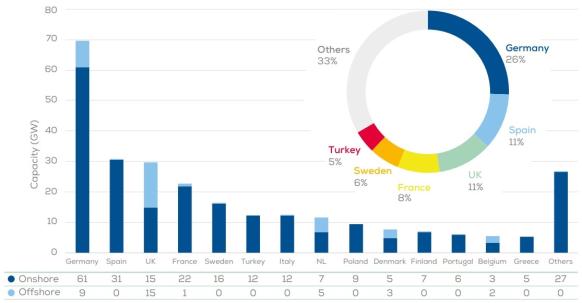Portugal's leap into floating wind clouded by snap election
Portugal’s government must establish offshore wind pricing and regulation that mitigates risks to hit its target of allocating 3.5 GW of floating wind this year.

Related Articles
Last year, approximately 50 companies from 10 countries ― including oil groups Equinor and Repsol and utilities RWE and Iberdrola ― expressed non-binding interest in bidding for the first commercial-scale floating wind projects in Portugal.
The Portuguese government planned to auction 3.5 GW of capacity in 2024 and 10 GW by 2030 and opened a consultation with industry to discuss prequalification and bidding models.
However, the resignation in November of Prime Minister Antonio Costa and a snap election scheduled for March 10 has disrupted progress towards a stable regulatory framework and stirred market uncertainty.
Offshore wind investors have taken a “wait and see” approach, analysts told Reuters Events.
Portugal's deepwater Atlantic coastline and maritime infrastructure offers strong potential for floating wind deployment. The key challenge for developers is an "undefined regulatory framework and route to market mechanisms," Ana Pirrone, country manager for Spain and Portugal at consultancy OWC, said.
"This has been exacerbated by the recent political uncertainty,” she said.
Polls suggest the election could result in a hung parliament. If an opposition party comes out on top, some delays could be expected while the new government gets up to speed, said Cristina Fernandez, European Sales Director at K2 Management, an engineering and management consultancy.
“The good news is that the election is in a few weeks so we will know pretty soon, and in the meantime the dialogue with potential investors continues,” she said.
Some investors could lose interest due to the uncertainty, warned Carla Ribeiro, Head of Offshore Wind Advisory for the U.K. and Ireland at Ramboll, an engineering and consultancy group.
Portugal's political uncertainty comes as several major offshore wind developers adapt global portfolios and focus on core markets following soaring costs and project delays. On February 7, leading offshore wind developer Orsted trimmed investment and capacity targets and said it would exit markets in Portugal, Spain and Norway.
“It’s a tendency that we have observed lately, for developers to focus only on just a handful of markets that are familiar to them,” Ribeiro said.
Launching offshore
Portugal's nascent offshore wind market benefits from an established supply chain for towers and blades, as well as numerous several ports that could be upgraded to serve offshore wind projects, Pirrone notes. Close proximity to Spain provides access to a large number of offshore wind manufacturers and potential power export opportunities.
Installed wind power in Europe by country (end of 2023)
(Click image to enlarge)
Source: WindEurope, February 2024
Floating wind remains an emerging technology but risk profiles have been aided by the successful installation of the 25 MW Windfloat Atlantic floating wind projects off the coast of northern Portugal.
Commissioned in 2020, Windfloat Atlantic generated 80 GWh in 2023, "exceeding the production expectations," developer Ocean Winds said. Analysts were concerned about strong waves off the Portuguese coast but WindFfloat Atlantic has proven resilient.
Portugal's wind resources are not as strong as in more northern floating wind markets such as the UK, France and Norway. Developers need more detailed site measurements and surveys for the Portuguese auction areas, as well as more detailed evaluation criteria, to build competitive and bankable bids.
“The fewer the data the higher the uncertainty and therefore the risk which, in turn, could impact their willingness to bid and/or the price they bid at,” Ribeiro wrote in an analysis published in September.
Ocean Winds, a joint venture by Portuguese utility EDPR and France's Engie, is interested in stepping up to commercial-scale projects in Portugal and urges the government to award contracts for difference (CfDs) in auctions and index prices to account for fluctuations in supply costs and interest rates, said Jose Miguel Moreira Pinheiro, Country Manager for Southern Europe at Ocean Winds. Governments are increasingly using the guaranteed fixed price mechanisms of CfDs to attract investors and minimise price increases for consumers, and have started to index prices to inflation after volatile costs since the pandemic prompted the delay and cancellation of some projects.
Portuguese officials must also streamline permitting processes and set a clear timeline for future auctions, analysts said. Across Europe, developers and suppliers have called for a clear pipeline of projects to justify investments and minimise costs.
Attracting suppliers
Portugal must also invest in ports and grid infrastructure to enable large-scale floating wind deployment, said Aaron Smith, chief commercial officer at Principle Power, developer of the Windfloat substructure technology.
“Ports are particularly important. The government should focus its attention on ensuring suitable ports to attract supply chain clusters within an encompassing coordinated nationwide strategy,” Smith said.
Future commercial floating wind projects should have a minimum capacity of 1 GW because "volume is crucial for bringing costs down" and the government should offer "realistic" auction prices and consider factors other than costs in project bids, Smith said. The UK government is inserting supply chain criteria in future offshore wind auctions.
“Building a sustainable and robust domestic supply chain is a goal that is at odds with a ‘least price’ approach to offshore wind procurement. Experience from other markets suggests that seeking minimum power price in the beginning of a market can put extreme pressure on suppliers and force them to accept costs and take risks that they are not prepared for,” Smith said.
Many suppliers are "interested in investing in new factories for subcomponents as well as assembly facilities. However, these investments are dependent on the stable predictable market signals,” he said.
Reporting by Eduardo Garcia
Editing by Robin Sayles

